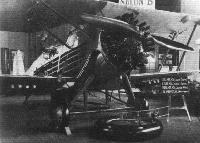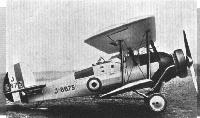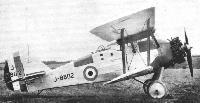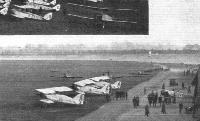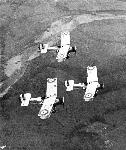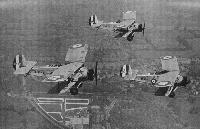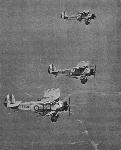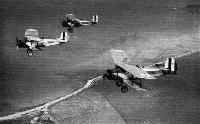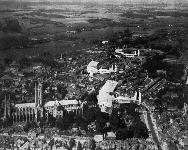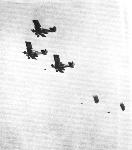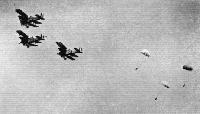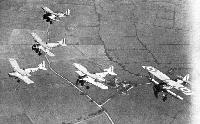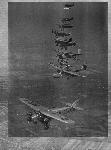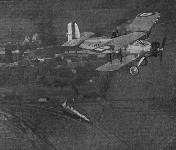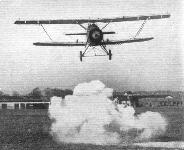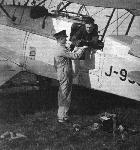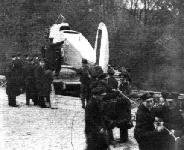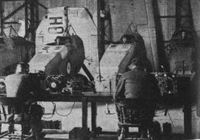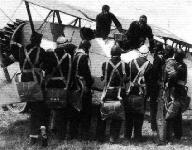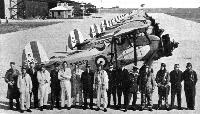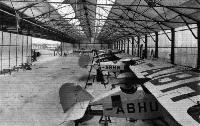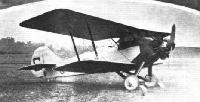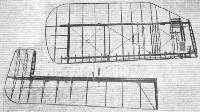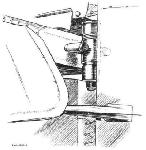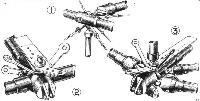
Описание
Страна : Великобритания
Год : 1925
Двухместный самолет поддержки сухопутных войск и учебно-тренировочный
Варианты
- Armstrong Whitworth - Atlas / Ajax - 1925 - Великобритания
- Armstrong Whitworth - Aries / A.W.17 - 1930 - Великобритания
Armstrong Whitworth Atlas
Выполнивший первый полет 10 мая 1925 года, Atlas стал первым самолетом британских ВВС, специально разработанным для поддержки сухопутных войск. Он строился довольно большой серией - всего британская авиация получила 446 машин (включая 175 учебно-тренировочных Atlas Trainer, спроектированных по требованиям от 1931 года). Поначалу самолет проектировался в инициативном порядке, а его гражданский прототип переделали согласно требованиям военных, после чего машина получила военный серийный номер, как и два демонстрационных образца. Один из них демонстрировался на Парижском авиасалоне в декабре 1926 года, а затем совершил рекламное турне по Южной Америке.
По результатам сравнительных испытаний Atlas выиграл конкурс у Bristol Type 93 Boarhound, de Havilland DH.56 Hyena и Vickers Type 113 Vespa, хотя военные и потребовали внести в его конструкцию ряд изменений. Затем в 1927 году в Эндовере прошли эксплуатационные испытания, и в октябре первые серийные Atlas поступили на вооружение дислоцированной в Кэттерике (Йоркшир) 26-й эскадрильи. Поставки в заморские части начаты в начале 1930 года - первой стала находившаяся в Египте 208-я эскадрилья, где Atlas сменили истребители Bristol F.2B.
Помимо использования в интересах сухопутных войск аэропланы данного типа применялись в британских ВВС и как связные. Фотографическое училище в Фарнборо также использовало в своей работе эти самолеты. Вариант с двойным управлением являлся основным учебно-тренировочным самолетом британских авиационных училищ с 1931 года до принятия на вооружение в 1933 году учебных самолетов Hawker Hart Trainer. Четыре гражданских самолета с 1931 года эксплуатировались в авиационном училище фирмы "Armstrong Whitworth", пока школа не переехала из Уитли в Хэмбл, получив новое название - "Air Service Training Ltd".
Военный вариант Atlas пошел и на экспорт: Канада закупила 16 машин, Греция - 2, Китай -14, Япония - 1. Канада в декабре 1927 - октябре 1929 года получила шесть новых самолетов, а в ноябре 1934 года - 10 машин, снятых с вооружения британских ВВС, Один из канадских аппаратов переделали в учебно-тренировочный вариант, В Канаде последний Atlas списали в 1942 году. Один снятый с вооружения британских ВВС самолет был продан Египту. Всего же, включая поставки на экспорт, построили 478 самолетов Atlas.
С февраля 1932 года британские ВВС приступили к замене Atlas на самолеты Hawker Audax, а учебно-тренировочному Atlas замена в виде самолета Hart Trainer пришла в августе 1933 года.
Модификации
Atlas Mk I: серийный вариант гражданского и военного назначения
Atlas Mk II: 14 самолетов для Китая имели фюзеляж новой конструкции и хвостовое оперение большей площади, так как самолет предназначался для использования в качестве истребителя и дневного бомбардировщика; самолеты имели ряд других отличий, включая двигатель Armstrong Siddeley Panther IIA мощностью 535 л.с; максимальная взлетная масса 2245 кг, максимальная скорость на уровне моря 245 км/ч; также построено три гражданских самолета Alias Mk II
ТАКТИКО-ТЕХНИЧЕСКИЕ ХАРАКТЕРИСТИКИ
Armstrong Whitworth Atlas Mk I
Тип: двухместный самолет поддержки сухопутных войск и учебно-тренировочный
Силовая установка: один звездообразный двигатель Armstrong Siddeley Jaguar IVC мощностью 400 л. с. (298 кВт)
Характеристики: максимальная скорость на уровне моря 229 км/ч; время набора высоты 1525 м - 5 мин 30 с; практический потолок 5120 м; продолжительность полета 3ч 15мин
Масса: пустого 1157 кг; максимальная взлетная 1823 кг
Размеры: размах крыла 12,06 м; длина 8,71 м; высота 3,20 м; площадь крыла 36,32 м'
Вооружение: один неподвижный стреляющий вперед 7,7-мм пулемет и один 7,7-мм пулемет на турели в задней кабине, до 218 кг бомб на внешней подвеске
Описание:
- Armstrong Whitworth Atlas
- Armstrong Whitworth Ajax
- Flight, December 1926
The Paris Aero Show 1926 - Flight, July 1928
THE ARMSTRONG WHITWORTH "ATLAS" - Flight, June 1929
BRITISH AIRCRAFT AT OLYMPIA - Flight, October 1931
Two New Military Aircraft - Flight, November 1932
British Aircraft
Фотографии
-
Flight 1929-07 / Flight
ARMSTRONG-WHITWORTH "ATLAS": Army Co-operation 'plane with Armstrong Siddeley "Jaguar."
-
Flight 1927-06 / Flight
Armstrong-Whitworth "Atlas" (Armstrong-Siddeley "Jaguar"). This is a new type of Army Co-operation machine, designed, as the type title indicates, for work with the Army. The type also took part in last year's display, but the actual machine to be seen this year is a modified version for general purpose work, equipped with petrol tanks on the wings so as to give extra range. Fitted with a supercharged "Jaguar" the "Atlas" maintains a good performance up to 10,000 ft. or so. Dimensions may not be given, but it will be seen that the machine is very small and compact for its work. Armstrong-Whitworth all-metal construction is used throughout.
-
Flight 1930-12 / Flight
The Armstrong Whitworth Atlas. Under it an Argosy wheel and a model of Argosy.
Другие самолёты на фотографии: Armstrong Whitworth Argosy - Великобритания - 1926
-
Flight 1927-03 / Flight
Armstrong Whitworth "Atlas" (Armstrong Siddeley "Jaguar"). The Armstrong Whitworth "Atlas" might be described as a near relation of the famous "Siskin" family, to which it bears a strong resemblance, although it is a two-seater designed for Army co-operation work. It is one of the several types of this class of machine recently produced at the request of the Air Ministry, as the time must soon be approaching when the present machine in use - the Bristol Fighter - will have to be replaced by up-to-date equipment. A number of "Atlas" "Co-ops" have therefore been put into service with No. 13 Squadron, Andover.
-
Aeroplane Monthly 1989-09 / R.Williams - Atlas: a supporting role (1)
Регистрационный номер: G-EBLK The first prototype Armstrong Whitworth Atlas I, G-EBLK, was built at Whitley, from where it made its maiden flight on May 10,1925 in the hands of Frank T. Courtney.
-
Aeroplane Monthly 1989-09 / R.Williams - Atlas: a supporting role (1)
Регистрационный номер: G-EBYF [4] Another view of the prototype Atlas I, G-EBLK (G-EBYF ???).
-
Aeroplane Monthly 1989-10 / R.Williams - Atlas: a supporting role (2)
Регистрационный номер: G-EBYF [4] BRITISH AIRCRAFT TYPES WHICH ARE BEING FLOWN AT EL PALOMAR: 4, Armstrong-Whitworth "Atlas," with Armstrong-Siddeley "Jaguar" engine.
Fitted with a Mk I fuselage and Mk II wings, Atlas AC G-EBYF was used for Mk II development. -
Aeroplane Monthly 1989-10 / R.Williams - Atlas: a supporting role (2)
Регистрационный номер: G-ABIV [6] The second prototype Atlas II was originally marked A-3. It received the marks G-ABIV in October 1931, after flight testing had been completed. It was kept by the parent company and used for Tiger engine development work.
-
Aeroplane Monthly 1989-10 / R.Williams - Atlas: a supporting role (2)
Регистрационный номер: G-ABIV [6] The second prototype Atlas II, G-ABIV, photographed after it was fitted with a new fin and rudder in an attempt to improve spin recovery. Powered by a supercharged Panther IIIA engine, the Atlas made its first flight in May 1931.
-
Aeroplane Monthly 1989-10 / R.Williams - Atlas: a supporting role (2)
Регистрационный номер: G-ABIV [6] The same aircraft with Tiger engine and modified rear fuselage.
-
Aeroplane Monthly 1989-10 / R.Williams - Atlas: a supporting role (2)
Регистрационный номер: G-ABIV [6] Atlas II G-ABIV in its fully developed form.
-
Aeroplane Monthly 1989-10 / R.Williams - Atlas: a supporting role (2)
Регистрационный номер: G-ABKE [2] The third Atlas Mk II, G-ABKE, was completed in September 1931 and was delivered to 4 Sqn at Farnborough for service evaluation. It later passed to 16 Sqn at RAF Old Sarum for night-flying trials.
-
Flight 1931-10 / Flight
Регистрационный номер: G-ABKE [2] THE ATLAS II: Such points as the new rudder shape, the built-in tail lamp, the neat "slots," and general cleanliness make it immediately apparent as to where this efficient two-seater gets its performance.
-
Flight 1932-11 / Flight
A MILITARY REPRESENTATIVE AT HANWORTH: An Armstrong Whitworth "Atlas" Mark II (Panther engine). This machine has wings of CYH section, and seems to hang in the air remarkably well at low speed. Note the anti-drag engine cowling.
-
Flight 1932-06 / Flight
ARMSTRONG WHITWORTH "ATLAS II" ("Panther III").
-
Flight 1929-07 / Flight
Регистрационный номер: J8675 ARMSTRONG WHITWORTH "ATLAS" (Armstrong Siddeley "Jaguar"). THE all-steel Atlas is the best aircraft for land or sea reconnaissance. It is the standard Army Co-operation two-seater of the Royal Air Force.
-
Flight 1928-07 / Flight
Регистрационный номер: J8802 -
Aeroplane Monthly 1989-10 / R.Williams - Atlas: a supporting role (2)
Регистрационный номер: J9039 Atlas AC J9039 of 26 Sqn. A couple of Siskins are just visible behind it.
Другие самолёты на фотографии: Armstrong Whitworth Siskin - Великобритания - 1921
-
Flight 1929-07 / Flight
Some of the Armstrong Whitworth machines: On the left the A.W.14, on the right the "Atlas," and behind them the "Siskin." Note that all are fitted with the "Townend ring."
Другие самолёты на фотографии: Armstrong Whitworth Siskin - Великобритания - 1921Armstrong Whitworth Starling / A.W.14 - Великобритания - 1927
-
Aeroplane Monthly 1990-03 / W.Smith - The Flying Shuftis
Регистрационный номер: K1574 Atlas K1574 of 208 Squadron snapped in 1933. It was from a batch of 96 Atlases delivered to the RAF between November 1930 and August 1931. Note the message hook just below the fuselage roundel.
-
Flight 1928-11 / Flight
HOUSEHOLD BRIGADE FLYING CLUB "AT HOME": Some of the thirty-odd machines gathered at Brooklands last Friday. Three Service "Atlas" Co-Ops. from No. 13 Squadron, R.A.F.
-
Air-Britain Aeromilitaria 1978-03
At the risk of appearing to over-emphasise airfields in this issue, the back cover photograph has been selected to illustrate one of the Royal Air Force's most famous overseas stations.
Lying between Cairo and the Suez Canal, Heliopolis was retained as a permanent station after the end of World War One when many Egyptian airfields closed down. It is perhaps best known as the home of the Victoria and Valentia bomber-transports which so typified the activities of the RAF in the Middle East between the wars. It also was a staging post on Imperial Airways routes to South Africa and the Far East.
In layout, it was typical of desert airfields in having its buildings clustered together within a perimeter fence. By tradition, the local inhabitants were assumed to be able to purloin anything not embedded in concrete, a much greater menace than air attack. At night, the gates were closed to leave only the landing ground open to stray visitors. In the photograph can be seen Fairey IIIFs and Atlases parked outside the wire while beside the large hangar sits a D.H.66 tri-motor of Imperial Airways. The three smaller hangars nearest to the large hangar were used by the airline and the RAF fence neatly loops back to allow them to guard their own property!
In the left background, safely isolated from the main camp, is the ammunition dump in its revetment and wired in separately.
The photograph was taken on 8 March 1929 by No.208 (Army Cooperation) Squadron.Другие самолёты на фотографии: De Havilland Hercules / D.H.66 - Великобритания - 1926Fairey Fairey IIIF - Великобритания - 1926
-
Flight 1928-10 / Flight
THE R.A.F. DISPLAY FOR A SULTAN: On October 11 the R.A.F. gave a Display at Hendon in honour of the Sultan of Muscat. Our illustration shows No. 26 Squadron at "Message Picking Up ";
-
Flight 1933-08 / Flight
ON MEDIUM PATROL: A flight of No. 26 (Army - Co-operation) Squadron over the Yorkshire Moors.
-
Flight 1930-06 / Flight
Регистрационный номер: J9541 [2], J9548 [2], J9549 [2] Отличительная черта всех военных самолетов Atlas - крюк для приема донесений под фюзеляжем, стреляющий вперед неподвижный пулемет и турель Scarff задней кабине.
A FLIGHT OF NO. 4 (ARMY. CO-OPERATION) SQUADRON. FLYING IN FORMATION -
Flight 1930-12 / Flight
Регистрационный номер: J9951, J9956 [3] No. 2 (A.C.) Squadron. A flight practising formation flying with the air gunners ready for action.
-
Flight 1932-08 / Flight
Регистрационный номер: K2516 OVER SALISBURY PLAIN: Armstrong-Whitworth "Atlases" of Cambridge University Air Squadron.
-
Flight 1930-06 / Flight
Регистрационный номер: J9541 [2], J9548 [2], J9549 [2] A FLIGHT OF NO. 4 (ARMY CO-OPERATION) SQUADRON. ATLAS AEROPLANES WITH JAGUAR ENGINES.
-
Flight 1933-08 / Flight
ECHELON ON THE RIGHT: Three A.W. "Atlas" machines with Armstrong-Siddeley "Jaguar" engines.
-
Flight 1933-08 / Flight
ROAD PATROL: No. 26 (A.C.) Squadron patrolling along the old Roman road.
-
Aeroplane Monthly 1990-03 / W.Smith - The Flying Shuftis
Регистрационный номер: J9970 [2], K1573 208 Sqn's C Flight over the River Nile returning from the flypast on February 3, 1933. Seen here are aircraft J9970 and K1573. The eye motif may just be discerned on the rudders.
-
Flight 1932-07 / Flight
A formation of Armstrong-Whitworth "Atlas" machines of O.U.A.S. flying along the coast of the Isle of Sheppey.
-
Flight 1932-12 / Flight
Регистрационный номер: K1175 [3] THE SHORES OF SHEPPEY: Three Armstrong-Whitworth "Atlases" of Oxford University Air Squadron out on the prowl.
-
Flight 1932-07 / Flight
Регистрационный номер: K1175 [3] OXFORD LOOKS DOWN ON CANTERBURY: The O.U.A.S. "Atlas" machines find a natural attraction in beautiful old cities and buildings.
-
Aeroplane Monthly 1990-03 / W.Smith - The Flying Shuftis
Регистрационный номер: K1554 Atlases of 208 Squadron flying past the Winter Palace Hotel, Luxor on December 12, 1932. K1554 may be seen at left.
-
Flight 1931-07 / Flight
"THAT'S THE STUFF TO GIVE THE TROOPS." NO. 13 (A.C.) SQUADRON DROPS SUPPLIES.
-
Flight 1932-07 / Flight
DROPPING SUPPLIES: Three Armstrong-Whitworth "Atlas" ("Jaguar") of No. 16 (Army Co-operation) Squadron.
-
Flight 1932-05 / Flight
A FORMATION OF AIRCRAFT TYPES USED FOR INSTRUCTION AT THE CENTRAL FLYING SCHOOL: From left to right, Gamecock, Atlas, Moth, III.F, Avro-Lynx, Siskin and Bulldog.
Другие самолёты на фотографии: Armstrong Whitworth Siskin - Великобритания - 1921Avro Avro 504N - Великобритания - 1920Bristol Bulldog - Великобритания - 1927De Havilland Gipsy Moth / Moth X - Великобритания - 1928Fairey Fairey IIIF - Великобритания - 1926Gloster Gamecock - Великобритания - 1925
-
Flight 1931-07 / Flight
A MIXED GRILL: A formation of seven different types over Wittering, viz., "Gamecock," "Atlas," "Moth," "Fairey III F," "Avro-Lynx," "Siskin," and "Bulldog."
Другие самолёты на фотографии: Armstrong Whitworth Siskin - Великобритания - 1921Avro Avro 504N - Великобритания - 1920Bristol Bulldog - Великобритания - 1927De Havilland Gipsy Moth / Moth X - Великобритания - 1928Fairey Fairey IIIF - Великобритания - 1926Gloster Gamecock - Великобритания - 1925
-
Flight 1933-08 / Flight
TRAINING TYPES: The machines from top to bottom are "Atlas," "Tutor," "Tiger Moth," "Tomtit" and "Siskin."
Другие самолёты на фотографии: Armstrong Whitworth Siskin - Великобритания - 1921Avro Tutor/Sea Tutor/Prefect / Type 621/646/626 - Великобритания - 1929De Havilland Tiger Moth / D.H.82 - Великобритания - 1931Hawker Tomtit - Великобритания - 1928
-
Flight 1934-05 / Flight
The staggering formation of aircraft was flown by instructors of Air Training Services Ltd in 1934. The aircraft are, from top to bottom: Avro Avian IVM, Avro Cadet, Avro Tutor, D.H.9J, Avro 626, Armstrong Whitworth Siskin III, Armstrong Whitworth Atlas, Saro Cutty Sark and an Avro Five.
Другие самолёты на фотографии: Armstrong Whitworth Siskin - Великобритания - 1921Avro Avian / Type 594/616 - Великобритания - 1926Avro Cadet / Type 631/643 - Великобритания - 1932Avro Five / Type 619 / Six / Type 624 - Великобритания - 1929Avro Tutor/Sea Tutor/Prefect / Type 621/646/626 - Великобритания - 1929De Havilland D.H.9J - Великобритания - 1926Saunders-Roe Cutty Sark / A.17 - Великобритания - 1929
-
Aeroplane Monthly 1990-03 / W.Smith - The Flying Shuftis
Регистрационный номер: J9970 [2] Armstrong Whitworth Atlases of 208 Squadron over rocky country in Egypt - 1933.
-
Flight 1930-12 / Flight
Регистрационный номер: J9956 [3] An Atlas of No. 2 (A.C.) Squadron photographing a railway junction.
-
Aeroplane Monthly 1989-10 / R.Williams - Atlas: a supporting role (2)
An Atlas AC of 208 Sqn on patrol in the Middle East. Based at Heliopolis, the squadron flew the Atlas from May 1930 until August 1935.
-
Aeroplane Monthly 1990-03 / W.Smith - The Flying Shuftis
A 208 Squadron Atlas flying over Egypt in 1933.
-
Aeroplane Monthly 1990-03 / W.Smith - The Flying Shuftis
208 Sqn Atlases in tight formation over Hinaidi on March 12, 1934.
-
Flight 1931-07 / Flight
"WE WANT MORE BEER." THE "ATLAS" MACHINES WITH HOOKS DOWN TO PICK UP MESSAGES
-
Flight 1929-07 / Flight
EVENT 7. MESSAGE PICKING UP: Three Armstrong-Whitworth Atlas machines of No. 26 (Army Co-operation) Squadron coming in, with hooks down, to pick up their messages.
-
Aeroplane Monthly 1990-03 / W.Smith - The Flying Shuftis
An Army Co-operation "Atlas" ("Jaguar") picking up a message. The "Atlas" is used by 208 (A-C) Squadron at Heliopolis, Egypt. In Great Britain the type used for this work is the "Audax" ("Kestrel")
A No 2 Squadron Atlas picking up a message by means of a retractable hook carried beneath the fuselage. The message was slung between two short posts on the ground. The system worked well, provided that the message was caught on the hook and not on any other part of the aircraft. -
Flight 1930-06 / Flight
Регистрационный номер: J9537 [3] AN ATLAS OF NO. 4 (A.-C.) SQUADRON PICKING UP A MESSAGE HUNG BETWEEN TWO STICKS
-
Flight 1930-06 / Flight
Регистрационный номер: J9537 [3] THE ARMSTRONG-WHITWORTH "ATLAS": Fitted with Armstrong-Siddeley "Jaguar" engine, this is now the standard Army Co-operation machine.
The classic Flight photograph of Atlas I AC J9537 of No 4 Sqn with message pick-up hook extended. The aircraft’s camera gun may just be seen inboard of the lower wing. Based at Farnborough, this unit received Atlases in October 1929 and retained them until January 1932, when Audaxes superseded them. -
Flight 1933-08 / Flight
Регистрационный номер: J9997 HELPING THE INFANTRY: View of an A.W. "Atlas" picking up messages which the infantry attach to a cord stretched between two posts.
-
Aeroplane Monthly 1989-10 / R.Williams - Atlas: a supporting role (2)
Регистрационный номер: J9956 [3] Atlas AC J9956 of 2 Sqn demonstrating its message pick-up capabilities at RAF Mansion in November 1930.
-
Flight 1930-12 / Flight
An Atlas of No. 2 (A.C.) Squadron bombing a ground target.
-
Aeroplane Monthly 1990-03 / W.Smith - The Flying Shuftis
Refuelling Atlases from an Imperial Airways refueller at Rutbah en route for Hinaidi, March 9,1934.
-
Aeroplane Monthly 1990-03 / W.Smith - The Flying Shuftis
Installing an LB-type plate-camera in the fuselage of a 2 Squadron Atlas. On the ground can be seen the simple wireless set then in use. It was fitted to a detachable tray and the whole set could be removed in a matter of seconds.
-
Flight 1930-12 / Flight
Preparing for vertical photography. The camera is inserted under the wireless panel, seen on the ground.
-
Flight 1933-08 / Flight
TESTING WIRELESS SETS: Three different sets can be carried on the "Atlas" according to whether its duty is artillery observation, close reconnaissance, or medium reconnaissance.
-
Aeroplane Monthly 1989-10 / R.Williams - Atlas: a supporting role (2)
Atlas AC 409 of the Royal Canadian Air Force. This aircraft served with No 22 (AC) Sqn at Trenton, Ontario and later at Rockcliffe. Two batches of Atlases were exported to the RCAF: a batch of six was supplied by Armstrong Whitworth between 1927 and 1929, and a batch of former RAF aircraft was sent out in 1934.
-
Flight 1934-03 / Flight
UNUSUAL MARKINGS: An Armstrong-Whitworth "Atlas II" ("Panther IIa") supplied to China. On the port top plane is the squadron marking. The national marking is carried on the starboard wing.
-
Aeroplane Monthly 1989-09 / R.Williams - Atlas: a supporting role (1)
Another Greek Atlas.
-
Aeroplane Monthly 1989-09 / R.Williams - Atlas: a supporting role (1)
Jaguar-powered Atlases of a Greek Naval Air Force squadron. Ten Atlases were built under licence by the Greek National Aircraft Company.
-
Flight 1935-04 / Flight
The arrival at Ingress Abbey of an "Atlas" aircraft with "Jaguar" engine, presented by the Air Ministry. These will be used for ground instruction only.
-
Flight 1940-11 / Flight
OLD FAITHFULS: Fuselages from Army Co-op. Atlases in use for training at a wireless school.
-
Aeroplane Monthly 1989-09 / R.Williams - Atlas: a supporting role (1)
Регистрационный номер: G-EBNI [2], J8792 [2] Atlas I J8792 became the first dual-control trainer and was flown for the first time in mid-1928.
-
Aeroplane Monthly 1989-09 / R.Williams - Atlas: a supporting role (1)
Регистрационный номер: J8792 [2], G-EBNI [2] The second Atlas, G-EBNI, built as a private venture and used as a company demonstrator, was taken on charge by the RAF as J9129 in June 1928.
-
Air Pictorial 1958-02
The aircraft is an Armstrong Whitworth Atlas trainer, one of the fourteen Atlases (R.C.A.F. Nos. 402-415) known to have been supplied to Canada, and of which no less than thirteen were on R.C.A.F. strength on the first day of the last war, 3rd September 1939.
-
Aeroplane Monthly 1989-09 / R.Williams - Atlas: a supporting role (1)
Регистрационный номер: G-ABDY G-ABDY was an improved dual-control variant of the Atlas I, recognizable by way of its aerodynamically balanced rudder and lack of fin. Powered by a 450 h.p. Jaguar I VC, 'DY became a company demonstrator.
-
Aeroplane Monthly 1986-05 / Personal album
Регистрационный номер: K1478 The Armstrong Whitworth Atlas Trainer was a two-seat dual-control trainer variant of the army co-operation Atlas. K1478 was probably delivered to the Royal Air Force College at Cranwell during the winter of 1930-31. Its flying career came to an abrupt end on October 22, 1935 when it spun in and was destroyed. The Atlas Trainer was issued to a number of training schools for advanced instruction and as a station communications aircraft. It differed in appearance from the standard Atlas by way of the modified rear cockpit, deletion of the Scarff gun-ring, the absence of the characteristic message hook and the forward-firing Vickers
-
Aeroplane Monthly 1989-10 / R.Williams - Atlas: a supporting role (2)
Регистрационный номер: K2523 Atlas Trainer K2523 of 5 FTS seen at RAF Sealand. Part of a batch of 53 Trainers delivered to the RAF between September 1931 and July 1932, this Atlas became 723M in October 1935.
-
Aeroplane Monthly 1989-10 / R.Williams - Atlas: a supporting role (2)
Регистрационный номер: K1187, K1188, K1189, K1190 Part of a batch of 26 Atlas Trainers delivered to the RAF between April and June 1930, photographed at Whitley Abbey. In the background at left may be seen the S.E.5a G-EBIB.
Другие самолёты на фотографии: RAF S.E.5 - Великобритания - 1916
-
Flight 1932-08 / Flight
WAITING THEIR TURN: Cambridge men in flying kit watch an instructor and pupil.
-
Aeroplane Monthly 1994-04 / H.Scanlan - Over dreaming spires (1)
Oxford University Air Squadron members studying a map on the wing of a squadron Atlas during Summer Camp at Eastchurch in July 1932.
-
Flight 1932-11 / Flight
ARRIVAL OF VICE CHANCELLOR: Rev. F. J. Lys, M.A., being assisted out of his machine by his pilot, Wing. Com. Park, and the A.O.C. in C.
-
Aeroplane Monthly 1989-09 / R.Williams - Atlas: a supporting role (1)
Регистрационный номер: G-ABOO Another Atlas Trainer used by the Armstrong Whitworth Reserve Flying School. It was delivered in November 1931, shortly before the move to Hamble.
-
Aeroplane Monthly 1989-09 / R.Williams - Atlas: a supporting role (1)
Регистрационный номер: G-ABHV [2] G-ABVH was another Atlas Trainer used by the Armstrong Whitworth Reserve Flying School. After transferring to AST at Hamble it was, in company with other Atlas Trainers, scrapped in 1938.
-
Aeroplane Monthly 1989-09 / R.Williams - Atlas: a supporting role (1)
Регистрационный номер: G-ABHW [4] Atlas DC trainer G-EBHW, delivered to the Armstrong Whitworth Reserve Flying School in April 1931. The school was later transferred to Hamble.
-
Aeroplane Monthly 1989-09 / R.Williams - Atlas: a supporting role (1)
Регистрационный номер: G-ABHX Atlas DC G-ABHX followed in the slipstream of her sister ship.
-
Aeroplane Monthly 1979-03 / J.Corlett - One good turn
An Armstrong Whitworth Atlas Trainer awaits a swing in the Middle East.
-
Jane's All the World Aircraft 1980 / Encyclopedia of Aviation - Aircraft A-Z - v2
Регистрационный номер: K1175 [3] Armstrong Whitworth Atlas trainer.
-
Aeroplane Monthly 1977-09 / Personal album
Регистрационный номер: K1181, K1193, K1475 Back to Abu Suier with this formation of pupil-flown Armstrong Whitworth Atlas dual-control advanced trainers of 4 FTS, serialled K1475, K147-, K1181 and K1193. Powered by the 450 h.p. Armstrong Siddeley Jaguar IVC, the Atlas Trainer, of which 175 were supplied to the RAF, soldiered on from 1931 until the appearance of the Hart Trainer in 1935.
-
Air-Britain Aeromilitaria 1985-03
The Atlases of No.208 Squadron and the Wapitis of No.55 at Heliopolis.
Другие самолёты на фотографии: Westland Wapiti - Великобритания - 1927
-
Air Enthusiast 1996-05 / R.Bonser - Hamble Pictorial. Air Service Training in the 1930s
Регистрационный номер: G-ABHW [4] AST was formed by Armstrong Whitworth in 1931 with a large hangar built for the flying school on the north airfield (the former Avro factory and flying field being to the south). In this view of the crowded school hangar, the DH.83 Fox Moth G-ACCA helps to date the picture. This was registered in February 1933 but exported to Australia the following September, becoming VH-UTY. Other types in view are the staple of the school, with A W Atlas Trainer G-ABHW (registered April 1931, scrapped in 1938) in the left foreground. Behind the Fox Moth is Avro 621 Tutor G-ABIS which served with AST from March 1931 through to October 1941 as HM505 (by which time the school was designated 3 EFTS), becoming instructional airframe 3064M in April 1942. Behind the Atlas is Avro 631 Cadet G-ABYC which is another interloper, not having served with AST. This machine is the longest survivor of those identifiable in the photo, being broken up at Barton, Manchester in mid-1951.
Другие самолёты на фотографии: Avro Cadet / Type 631/643 - Великобритания - 1932Avro Tutor/Sea Tutor/Prefect / Type 621/646/626 - Великобритания - 1929De Havilland Fox Moth / D.H.83 - Великобритания - 1932
-
Flight 1932-09 / Flight
Регистрационный номер: G-ABHW [4] AN AMPLE INTERIOR: Air Service Training at Hamble like plenty of room for their machines, and they get it in this B. &. P. hangar, which is 300 ft. long and 70 ft. wide.
Другие самолёты на фотографии: Armstrong Whitworth Siskin - Великобритания - 1921
-
Flight 1932-07 / Flight
Регистрационный номер: G-ABHV [2], G-ABHW [4] A view out of the hangar at Hamble, showing the "Avians," "Cadets," "Atlases" and "Siskins" used by A.S.T.
Другие самолёты на фотографии: Armstrong Whitworth Siskin - Великобритания - 1921Avro Avian / Type 594/616 - Великобритания - 1926Avro Cadet / Type 631/643 - Великобритания - 1932
-
Flight 1936-12 / Flight
APPOSITE: Christmas greetings from Air Service Training Ltd. at Hamble. The message is formed by white-overalled humanity "on the hands down," and the "A.S.T." consists of the ten different aircraft types which form the organisation's fleet: Avro V, 626, Avian, Tutors and Cadets; two-seater Siskin; A.W. Atlas; two Cutty Sarks; and D.H. Leopard Moth and Hornet Moth.
Другие самолёты на фотографии: Armstrong Whitworth Siskin - Великобритания - 1921Avro Avian / Type 594/616 - Великобритания - 1926Avro Cadet / Type 631/643 - Великобритания - 1932Avro Five / Type 619 / Six / Type 624 - Великобритания - 1929Avro Tutor/Sea Tutor/Prefect / Type 621/646/626 - Великобритания - 1929De Havilland Hornet Moth / D.H.87 - Великобритания - 1934De Havilland Leopard Moth / D.H.85 - Великобритания - 1933Saunders-Roe Cutty Sark / A.17 - Великобритания - 1929
-
Aeroplane Monthly 1989-10 / R.Williams - Atlas: a supporting role (2)
Half a dozen Atlas Trainers under construction at Whitley Abbey. The Atlas remained in production until 1933. Of the 446 total built, 175 were Trainers. Entering RAF service in October 1927, with No 26 Squadron, the type was eventually supplanted by the Hawker Hart and Audax.
-
Flight 1926-12 / Flight
Ajax мало отличался от своего предшественника - самолета Atlas, поэтому довольно часто между ними возникала путаница.
The Armstrong-Whitworth "Ajax": A two-seater general purpose aeroplane with "Jaguar" engine. Can be fitted with float undercarriage. -
Flight 1925-07 / Flight
The Armstrong-Whitworth "Ajax," entered by Mr. J.D. Siddeley, is a two-seater biplane fitted with 395 h.p.Siddeley "Jaguar" engine. In the competition this machine will be piloted by Mr. Frank Courtney.
-
Aeroplane Monthly 1989-09 / R.Williams - Atlas: a supporting role (1)
Регистрационный номер: J9998 [2] Powered by a 550 h.p. Panther VI radial engine, Atlas J9998 was fitted with Armstrong Whitworth-designed stainless steel floats in 1929.
-
Flight 1931-09 / Flight
Регистрационный номер: J9998 [2] BUS OF ALL JOBS: An Armstrong-Whitworth "Atlas" ("Jaguar") seaplane used by the High-speed Flight at Calshot.
-
Flight 1930-12 / Flight
Two views showing a left-hand lower wing of an Atlas (above), and an aileron, both being good examples of the Armstrong-Whitworth steel construction.
-
Aeroplane Monthly 1989-10 / R.Williams - Atlas: a supporting role (2)
Регистрационный номер: G-ABIV [6] The cockpit of the Tiger-engined Atlas test machine, G-ABIV. Most of the labelling relates to the test engine.
-
Aeroplane Monthly 1989-10 / R.Williams - Atlas: a supporting role (2)
The gunner’s cockpit in the Atlas I, with the pilot’s cockpit forward.
-
Aeroplane Monthly 1989-10 / R.Williams - Atlas: a supporting role (2)
Регистрационный номер: G-ABIV [6] Two views of the balanced gun turret fitted to Atlas II G-ABIV in 1934.
-
Aeroplane Monthly 1976-10 / Personal album
Регистрационный номер: K1195 The engineless Armstrong Whitworth Atlas (DC) K1195 was photographed at Hanworth in 1931. Note the damaged port aileron. The first Atlas flew in May 1925 and a total of 499 was built. Used in the Army Co-operation/advanced trainer role, the Atlas was eventually superseded by the Hawker Hart.
-
Air-Britain Archive 1981-04
Регистрационный номер: G-EBYF [4] The photograph of Armstrong Whitworth Atlas G-EBYF comes to us from H.W.Harper MBE via Flt/Lt G.R.Sunderland (Retd), who comments that it appears to have been taken in 1931 in Argentina, although the exact date and place are unknown. We have no further information, nor does Peter Moss throw any further light on the matter - can any reader assist?
-
Aeroplane Monthly 1989-10 / R.Williams - Atlas: a supporting role (2)
Регистрационный номер: G-EBYF [4] The Atlas II prototype G-EBYF photographed following its landing accident at El Palomar aerodrome, Argentina on March 23, 1931. The aircraft was shipped back to Whitley and repaired.
-
Aeroplane Monthly 1990-03 / W.Smith - The Flying Shuftis
Регистрационный номер: JR9971 Atlas JR9971 at No 4 Landing Ground beside the Suez Road on June 6, 1932, following the accident described by the author. This rebuilt Atlas remained with 208 Squadron until June 1934.
-
Aeroplane Monthly 1989-10 / R.Williams - Atlas: a supporting role (2)
Регистрационный номер: JR9961, KR1011 Left, rebuilt Atlas I JR9961 of 208 Sqn snapped after overturning at Suez Road on June 8, 1934.
Right, rebuilt Atlas AC KR1011 of No 4 FTS photographed, probably, following its take-off accident at Abu Sueir on September 26, 1935. -
Aeroplane Monthly 1974-03 / J.Corlett - Write-off and laugh-off
Two views of the Armstrong Whitworth Atlas which stalled and “dropped about 20ft nose first” on approach.
-
Aeroplane Monthly 1988-12 / P.Masefield - Wren
Wren's first contribution to C. G. Grey's The Aeroplane was published in the issue for June 22, 1933. It was titled: Identification made easy - a caricaturist’s memories of the prominent characteristics of some popular aeroplanes.
Другие самолёты на фотографии: Airspeed Ferry / AS.4 - Великобритания - 1932Avro Avro 504 - Великобритания - 1913Blackburn Bluebird / L.1 - Великобритания - 1924Blackburn Iris / R.B.1 - Великобритания - 1926Bristol Bulldog - Великобритания - 1927Cierva/Avro C.30A / Rota - Великобритания - 1932Comper Swift / CLA.7 - Великобритания - 1930De Havilland Gipsy Moth / Moth X - Великобритания - 1928De Havilland Puss Moth / D.H.80 - Великобритания - 1929Fairey Fairey IIIF - Великобритания - 1926Handley Page H.P.42 / H.P.45 - Великобритания - 1930Handley Page Hyderabad/H.P.24 / Hinaidi/H.P.33 / Clive/H.P.35 - Великобритания - 1923Hawker Fury - Великобритания - 1931Klemm L.25 - L.28 Swallow - Германия - 1927Supermarine Southampton / Solent - Великобритания - 1925Vickers Jockey / Type 151 - Великобритания - 1930Vickers Virginia - Великобритания - 1922Westland Wapiti - Великобритания - 1927Westland Widgeon - Великобритания - 1924
-
Flight 1926-12 / Flight
ON THE ARMSTRONG.WHITWORTH "AJAX": Spring-loaded turnbuckles are incorporated in the landing wires so as to keep them taut under all conditions. The strut attachment is neatly faired in aluminium sleeve held in place by a split pin.
-
Flight 1926-12 / Flight
The tail trimming gear of the Armstrong-Whitworth "Ajax" is mounted externally and is very accessible.
-
Flight 1929-07 / Flight
Metal ribs and their attachment to main spar on the Armstrong Whitworth "Atlas."
-
Flight 1929-07 / Flight
Details of steel spars and interplane and drag strut attachments on the "Atlas."
-
Flight 1929-07 / Flight
A typical fuselage joint as used on the Armstrong Whitworth "Atlas."
-
Flight 1931-10 / Flight
STEEL CONSTRUCTION: Sketches 1, 2 and 3 are typical examples of Armstrong-Whitworth steel tube construction. They show, in particular, the ball and cup method of attaching the vertical fuselage struts.
-
Flight 1931-10 / Flight
DETAILS THAT COUNT: Above, our artist shows how the tail lamp has been fitted snugly into the rudder, while below he depicts the method by which the tail plane has been faired to the fuselage of both the Atlas II and A.W.XVI.
Другие самолёты на фотографии: Armstrong Whitworth Scimitar / A.W.16 / A.W.35 - Великобритания - 1931
-
Flight 1929-07 / Flight
Armstrong-Whitworth "Atlas" Armstrong Siddeley "Jaguar" Engine
-
Flight 1931-10 / Flight
Armstrong-Whitworth Atlas Mk.II Armstrong Siddeley Panther Mk.IIIA Engine
Тип фотографий
- Все фото (113)
- Ч/б фото (94)
- Кабина (3)
- Обломки (6)
- Рисунки, схемы (10)


